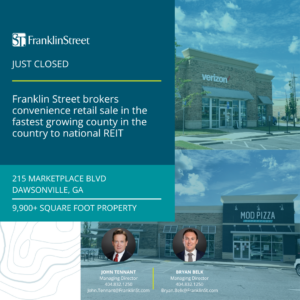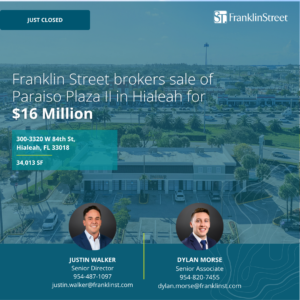All along the east coast of Florida, especially in the coastal counties and areas, multifamily investors are seeing the benefits of Class B and C properties as the rental market is squeezed while the workforce housing need increases. Long a staple of private and smaller real estate investors, these properties with less than 100 units are increasing in value and offering investors great opportunity for growth. Some of these properties haven’t changed hands in decades but are now on the market at competitive prices and opportunities for reinvestment and increased values.
As experts in multifamily investment properties situated from the First Coast south to the Treasure Coast, Franklin Street recommends that now is a great time for both buyers and sellers to assess apartment properties and opportunities. Owners should check on the values of their units and evaluate changes in their communities while investors are watching the potential for increased capital costs and rising interest rates. Occupancy rates are high in the east coast counties and rental demand continues to grow.
Spotlight on Space and Treasure Coasts
The growth of SpaceX is driving a lot of the employment demand and economic development along the Space and Treasure Coasts. SpaceX is working on a rocket that will be the most powerful yet, combined with the largest payload to eventually travel to Mars with astronauts onboard for exploration and to launch more weather satellites orbiting Mars.
Additionally, the area is seeing economic expansion and new development. Among the many projects, OneWebb, a satellite company, is nearing completion of a 100,000-square-foot, $85 million facility to build satellites. Port Canaveral is also building a new $150 million cargo terminal. The current average occupancy rates in multifamily properties in St. Lucie, Martin and Indian River Counties is 96.6 percent with all the counties above, 95 percent individually. In Brevard, the occupancy rate is nearly 96 percent.
The majority of Class B and C properties are located in well-established neighborhoods near schools, employment and shopping. This can give these units more of a community feel. Most brand-new Class A properties include 200 or more units and are typically located in surrounding areas that are waiting to be developed, which may not yet offer a true community.
Class B/C Affordability
These properties are popular with renters because they offer an affordable option compared to the larger and newer apartment communities. At sale, they typically have fewer amenities than the Class A properties. However, due to the same popularity with investors, many investors have improved these properties through extensive rehab to the interiors, exteriors and clubhouses (sometimes even gating the property). These changes attract tenants looking for an affordable option while enjoying updated units and added amenities such as a swimming pools, covered parking and the convenience of infill/established locations.
Investors continue to flock to Class B assets that provide relatively affordable housing at a level below the new Class A properties. In the past, investors would look to acquire these properties and spend additional thousands of dollars per unit to upgrade them. This was a value-add strategy designed to compete with the newer properties. Now, buyers see a market that will support these properties just as they are without major upgrades. “Keep-As-Is” has become the new workforce housing model and the market’s employment and wage growth support the cash flow and yield they require.
North Florida Economy
Jacksonville and North Florida are very healthy markets with a bright future, where multifamily assets still provide a better value for investors. There are many contributing factors, but the bottom line is market fundamentals continue to be very strong.
The Jacksonville economy continues to expand with growth at double the national average supporting performance of the multifamily market. Vacancy is down to 6.5 percent, 70 basis points lower than just a year ago. Effective rents are up 6.3 percent over last year. In contrast to what experts had predicted, concessions are down significantly, with concession packages dropping over 40 percent year-over-year and only 12 percent of the properties in the market offering such incentives.
Along the east coast, a high percentage of new units are being absorbed even as more construction comes on line. In addition, there are approximately 5,000 new units in the pipeline. In North Florida, sales volume has remained consistent with a steady growth in pricing to a median per unit price of over $90,000 and cap rate compression on the order of 40 to 50 basis points, depending on asset class.
Rising interest rates will remain a focus in 2018. Right now, lenders are holding rates down but compensating with terms that include lower loan-to-value ratios and shorter amortization periods.
The Jacksonville market has a median age of 38, younger than other Florida markets which have a much higher percentage of retirees. Single-family ownership remains a viable, though challenging, option for many renters. As a result, over 30 percent of households in the Jacksonville market are renters and there is consistent demand for apartments. Steady wage growth among the Top 10 markets in the country supports this demand across all classes of multifamily in the Jacksonville area. These trends are predicted to continue over the next 12 to 18 months.
The East Coast’s strong fundamentals will support further growth even if there is an economic downturn. Employment, wage growth and population growth in these markets should continue to boost multifamily performance. We could very well be approaching a market peak, so those who have been holding onto properties may have the opportunity they have been waiting for.
About Franklin Street: Celebrating more than 10 years in the business, Franklin Street is a family of full-service commercial real estate companies focused on delivering value-add solutions to meet the evolving needs of clients. Through a collaborative philosophy of leveraging the resources, expertise and experience of each of its divisions – Real Estate, Capital, Insurance, Property Management and Project Management – Franklin Street offers unmatched value and optimal solutions for clients nationwide. Learn more about Franklin Street at FranklinSt.com.
FOR INFORMATION
Jim Reed is director at Franklin Street Real Estate Services, specializing in multifamily brokerage throughout North Florida and Jacksonville. Reach him at [email protected] or (904)899-0310.
Matthew Kesterson is senior director at Franklin Street Real Estate Services, specializing in multifamily brokerage throughout Central East Florida. Reach him at [email protected] or (904)647-1432.



